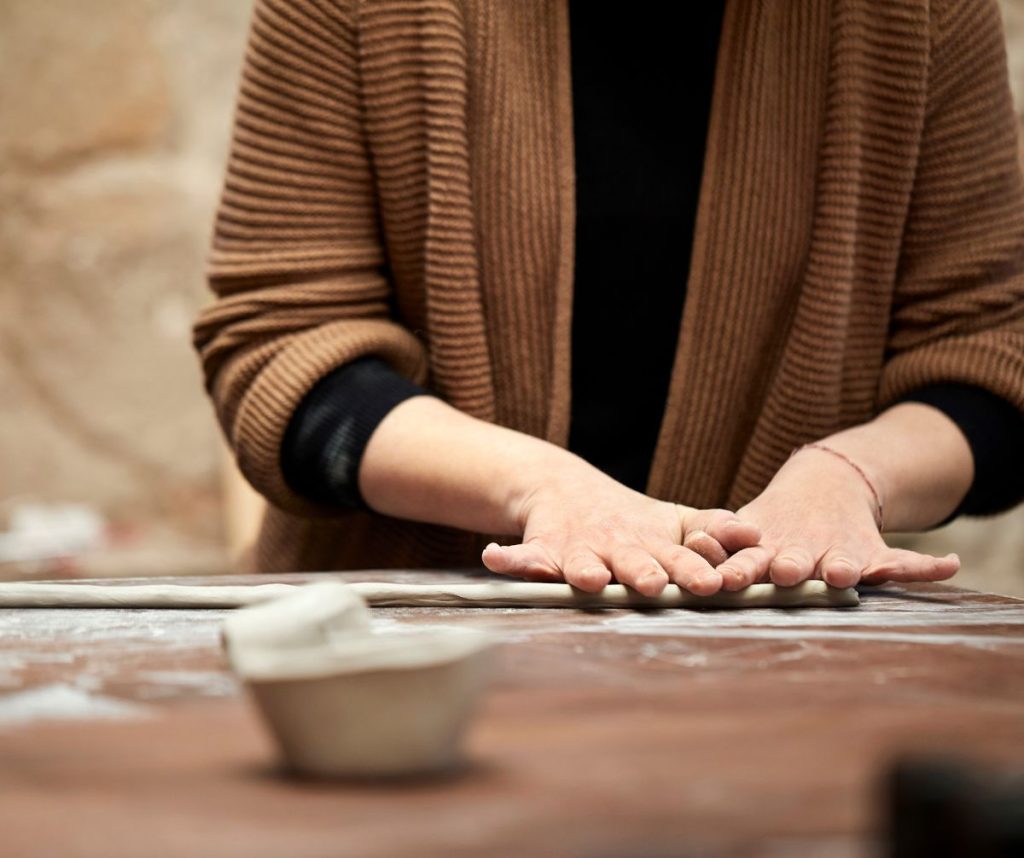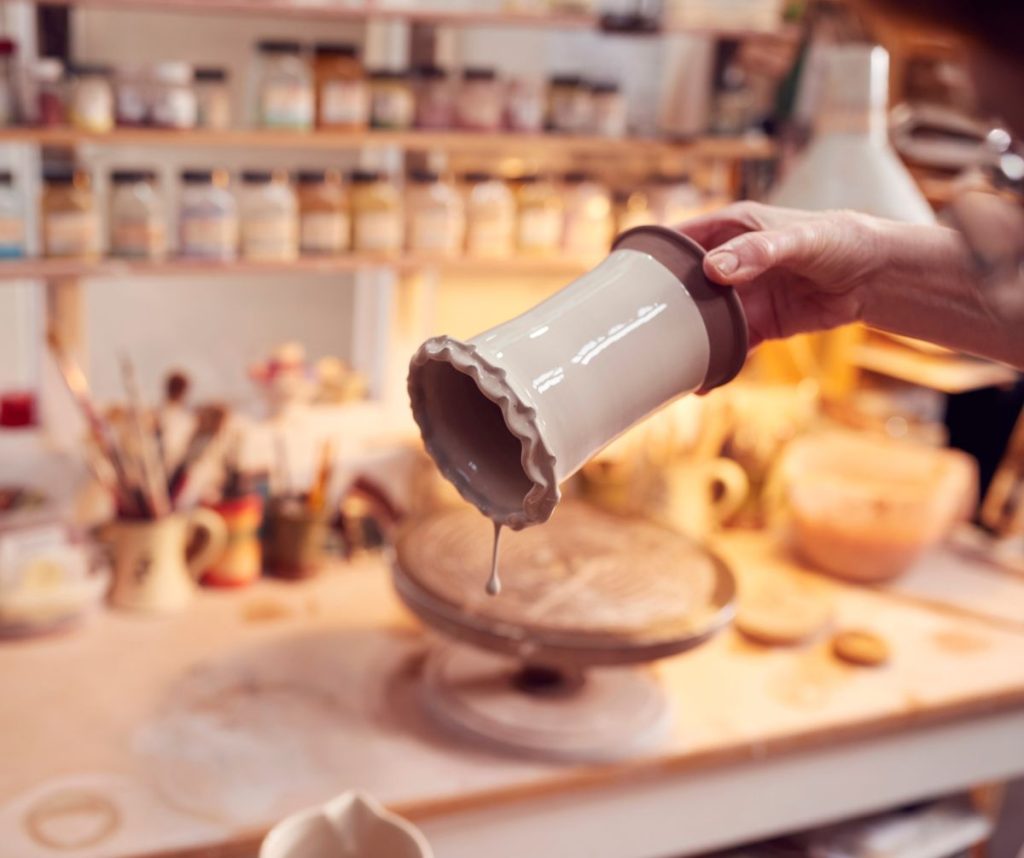Last Updated on July 11, 2025 by Team Ideas24
Ceramic sculpture weaves a story as old as time, morphing through the centuries into a vibrant canvas for artists. It’s a space where creativity knows no bounds, turning simple clay into works that dazzle both the eye and the soul.
Throughout history, ceramic artists have honed their craft, each generation adding its flair to enhance the allure of their creations. Today, I’m excited to share with you five techniques that have stood out, transforming mere clay into breathtaking pieces of art.
Do not be intimidated by the craft. You can learn these crafting techniques since sculpting is an accessible hobby. These methods aren’t just techniques; they’re invitations to embark on a creative odyssey, pushing the limits of what you thought possible in ceramic artistry.
So, are you ready to step into a realm where clay isn’t just clay but a vibrant medium for self-expression? Continue reading our guide to obtain these techniques in creating your ceramic sculptures.
Contents [show]
Exploring 5 Remarkable Techniques for Crafting Extraordinary Ceramic Sculptures
Step into the captivating exploration of five remarkable techniques that hold the key to crafting extraordinary ceramic sculptures. Within the realm of ceramic artistry, these techniques are revered for their ability to shape raw clay into captivating masterpieces.
1. Hand-Building
When it comes to ceramic sculpture, hand-building stands as the foundational technology that allows artists to shape clay with their own hands, free from the constraints of a potter’s wheel.

Embrace the art of coiling, pinching, and slab construction! With these techniques at your fingertips, you have the power to mold clay into a canvas of endless potential.
With every coil, pinch, or meticulously placed slab, a world of possibilities unfolds, revealing the remarkable textures and shapes that infuse your ceramic sculptures with life. It is through the precise manipulation of the clay that you can imbue your artwork with intricate details and expressive elements that make it truly extraordinary.
Coiling
Coiling is a versatile technique that involves creating long, snake-like clay coils and layering them to build forms. It is renowned for its ability to produce organic and flowing shapes.

Embrace the rhythmic nature of coiling as you gradually build your sculpture, allowing it to take shape in a fluid and natural manner. Coiling can be combined with other techniques to add volume, texture, and intricate detailing.
Pinching
Pinching is an ancient technique that involves shaping clay by hand through gentle pinching and squeezing motions. It allows for an intuitive and tactile approach to sculpting. Pinching can be used to create expressive forms, adding a sense of movement and fluidity to your sculptures.
Combining pinching with other techniques, such as coiling or slab construction, expands your possibilities, enabling you to infuse your creations with both organic and structured elements.
Slab Construction
Slab construction offers precision and the opportunity to create sharp angles and defined edges in your sculptures. By rolling out flat, even slabs of clay, you can cut and assemble them to form geometric shapes or intricate patterns.

The use of templates or molds can aid in achieving consistency and accuracy. Combining slab construction with other techniques adds dimension and complexity to your sculptural compositions.
As you delve deeper into the art of hand-building, you’ll find yourself honing your skills, developing a keen sense of touch and an understanding of the clay’s behavior. The more you work with the medium, the more you’ll discover the endless possibilities that lie within your grasp.
You’ll learn to navigate the challenges and embrace the happy accidents, turning them into opportunities for innovation and experimentation.
2. Wheel-Throwing
Few techniques possess the mesmerizing allure of wheel-throwing. With its inherent elegance and precision, this ceramic sculpture technique demands skill, practice, and an unwavering focus.
Through the rhythmic dance between the potter’s wheel and the artist’s hands, clay takes shape, transforming into symmetrical and refined forms that exude grace and sophistication.

At the heart of wheel-throwing lies the art of centering clay—a delicate process that requires both physical skill and a deep connection with the medium. As your hands gently guide the clay, you’ll feel its responsiveness, gradually coaxing it into a balanced and centered position on the wheel. This foundational step sets the stage for the creation of exquisite ceramic sculptures.
Once the clay is centered, you’ll embark on the exhilarating task of pulling up walls. With controlled movements, you’ll gradually lift the clay, coaxing it upward to form the body of your vessel.
The touch of your hands, the pressure of your fingers, and the guidance of your intuition all play a part in shaping the sculpture. As the clay responds to your touch, you’ll witness its transformation, witnessing the birth of a vessel that reflects both your artistic vision and the inherent qualities of the clay itself.
Precision is key in wheel-throwing, as it allows you to create vessels with meticulous attention to detail. By skillfully manipulating the clay, you can refine the shape, adjust the proportions, and make smooth contours that exude a sense of harmony and balance.
The potter’s wheel becomes more than just a tool; it becomes an extension of your artistic expression, an instrument that allows you to bring your creations to life with every turn.
While wheel-throwing is often associated with functional vessels like bowls, mugs, and vases, its potential extends far beyond mere utility. Artists with a penchant for exploration and innovation can push the boundaries of this technique, using it as a platform for sculptural endeavors.
By combining wheel-throwing with hand-building or carving techniques, intricate sculptural forms can emerge, captivating the viewer with their intricate details and unique aesthetic.
Wheel-throwing offers a mesmerizing journey of creative discovery. Each rotation of the wheel presents an opportunity to refine your craftsmanship, embrace spontaneity, and explore the interplay between form and function. The tactile experience of shaping clay on the wheel allows you to intimately connect with the material, forging a profound relationship that guides your artistic choices.
As you master the art of wheel-throwing, you’ll not only refine your technical skills but also develop a deep appreciation for the nuances of clay and its transformational nature. The symmetrical elegance and precise craftsmanship that emerge from this technique can elevate your ceramic sculptures, infusing them with a timeless quality that transcends the boundaries of art.

Within the captivating realm of ceramic art, wheel-throwing stands as a testament to the remarkable human ability to shape and mold the raw materials of the earth into objects of beauty and purpose. It is an art form that combines technical skill, artistic vision, and a deep connection with the clay, resulting in exquisite ceramic sculptures that inspire awe and admiration.
Extra Tip: Check out these creative ways to incorporate art into your home decor and infuse your living space with the beauty of unique creations!
3. Carving and Texturing
The transformative power of carving and texturing techniques is unrivaled. These techniques grant artists the ability to mold clay into dynamic and visually striking ceramic sculptures that ignite the imagination.
Carving
Carving is an art form that requires both precision and vision in a ceramic sculpture. As an artist, you have the power to shape and define your creations by carefully chiseling away at the clay’s surface. With each deliberate stroke of the carving tool, you bring your vision to life, unveiling the hidden beauty that lies within the raw material.
Precision is of paramount importance in carving, as it allows you to create intricate textures, refine contours, and add intricate details to your ceramic sculptures. By meticulously carving the clay, you can achieve a level of precision that captivates the eye and evokes a sense of admiration.
Every cut and incision is purposeful, contributing to the overall aesthetic and narrative of your artwork.

Texturing
Texture plays a pivotal role in the world of ceramic sculptures. The manipulation of clay’s surface can evoke a multitude of sensations and emotions. With the flick of a tool, such as a loop tool or wire tool, you can create intricate patterns, rough-hewn surfaces, or delicate etchings that infuse your sculptures with character and visual interest.
The interplay between smooth and textured surfaces adds a tactile quality that invites the viewer to explore your artwork on a deeper level.
It is in these fine details or intricacies that the story unfolds, revealing the artist’s touch and attention to even the smallest nuances. Whether it’s the subtle curves of a face, the delicate veins of a leaf, or the intricate patterns adorning a vessel, these details add a level of refinement and craftsmanship that captivates and engages the viewer.
Carving and texturing offer a unique sense of freedom and creativity. Unlike other mediums, clay is malleable, allowing for spontaneous exploration and experimentation. You can respond to the clay’s natural qualities, adapting your approach as you uncover unexpected forms and textures.
It is through this symbiotic relationship between artist and medium that extraordinary sculptures emerge, each one bearing the mark of the artist’s creative journey.
4. Surface Decoration
The surface of a ceramic sculpture holds immense potential for creative expression. It is a canvas where artists can experiment with various surface decoration techniques, like glazing, underglazes, and ceramic stains.
Glazing
Glazing, a widely popular surface decoration technique, offers an array of possibilities for ceramic artists. With a palette of colors at your disposal, you can layer glazes onto your ceramic sculptures, creating a visual feast for the eyes.
Glazes, composed of various minerals and pigments, are applied to the surface of the clay before firing. As the glazes melt and fuse during the firing process, they undergo a remarkable transformation, revealing stunning colors, captivating textures, and a radiant sheen that can only be achieved through the magic of glazing.

From subtle earth tones to bold and vibrant hues, the spectrum of glazes allows you to evoke specific moods, convey emotions, and enhance the overall aesthetic of your artwork. The firing process reveals the true nature of the glazes, unveiling mesmerizing transformations as they interact with the heat and chemical reactions within the kiln.
Underglazes
Underglazes provide alternative avenues for surface decoration. These versatile mediums offer artists the opportunity to add intricate details, create patterns, and achieve a wide range of effects on the surface of their sculptures. With underglazes, you can paint or draw directly onto the clay, creating precise lines and intricate designs.
Ceramic Staines
Ceramic stains allow for the manipulation of color intensity and texture, as they can be applied in washes or layered to achieve depth and complexity. By harnessing the potential of these techniques, you can infuse your ceramic sculptures with a personal touch and narrative, making each piece truly unique.
Use a soft-bristle brush to apply the stain directly onto the surface of the clay or bisque-fired pieces. Brush in smooth and even strokes, ensuring thorough coverage. Multiple layers can be used for more intense colors.
If you prefer a more even and controlled application, you can use an airbrush or a spray bottle to apply the stain. Dilute the stain mixture with water or a compatible medium according to the manufacturer’s instructions.
As you experiment with surface decoration techniques, consider the overall composition and concept of your ceramic sculpture. The careful selection and application of colors, textures, and patterns can reinforce your artistic intent and enhance the storytelling aspect of your artwork.
Whether you aim to evoke a sense of tranquillity, celebrate the beauty of nature, or express bold and vibrant energy, surface decoration techniques provide a powerful means to convey your artistic vision to the world.
5. Firing and Kiln Techniques
At its core, firing refers to the process of subjecting clay to high temperatures, causing physical and chemical changes that give rise to durable ceramic sculpture. Understanding the nuances of firing techniques is essential for artists to achieve their desired aesthetic results and bring their creative visions to life.

Bisque Firing
One of the primary firing techniques in ceramics is called bisque firing. This initial firing stage takes place after the clay has been shaped and dried. The purpose of bisque firing is to remove any remaining moisture from the clay and increase its strength and durability.
The ceramics are carefully loaded into the kiln. As the temperature rises, the water within the clay evaporates, leaving behind a porous structure that is ready for further artistic expression.
Glaze Firing
Glaze firing is where the true magic of ceramic artistry unfolds. This firing stage involves applying glazes onto the bisque-fired ceramics. The kiln becomes a transformative chamber as it reaches temperatures that cause the glazes to melt, fuse, and transform into a glassy surface coating.
This process not only adds aesthetic beauty but also creates a protective layer, enhancing the durability of the ceramic sculpture. Glaze firing requires precision and careful control of temperature, time, and kiln atmosphere to achieve the desired colors, textures, and effects.
Raku Firing
Beyond these traditional firing techniques, alternative methods open up a world of experimental possibilities. Raku firing, for instance, is known for its rapid and unique process. The ceramic sculptures are removed from the kiln at high temperatures and placed in a combustible material, creating a reduced environment.
This reduction process imparts distinctive metallic finishes, crackles, and a sense of spontaneity to the ceramic sculpture. Each raku-fired piece is unique, capturing the fleeting beauty of the moment.
Pit Firing
Pit firing, another alternative technique, harks back to ancient traditions where ceramics are fired in a primitive outdoor setting. The artworks, along with organic materials and combustibles, are placed in a pit or specially constructed structure.
The pit is then set ablaze, and the ceramic sculpture undergoes a transformative journey marked by the dynamic interplay of flames, smoke, and natural elements—pit firing results in earthy, rustic surfaces, showcasing the raw beauty of nature’s touch.
Kiln
The kiln itself plays a pivotal role in the firing process. Its design, insulation, and firing controls determine the distribution of heat, airflow, and kiln atmosphere. By strategically positioning the ceramics within the kiln, artists can influence the firing outcome, achieving even heat distribution, minimizing flaws, and maximizing artistic effects. Understanding the intricacies of kiln operation empowers artists to unleash the full potential of their creative vision.
Through precise temperature control, firing schedules, and careful placement, artists can unlock the transformative power of the kiln. The act of firing infuses vitality into their ceramic sculptures, unveiling the genuine embodiment of their artistic expression.
Unleashing Creativity and Mastery
The art of clay holds a captivating allure, allowing artists to shape extraordinary ceramic sculptures. By mastering these five amazing techniques—hand-building, wheel-throwing, carving and texturing, surface decoration, and firing and kiln—you can unlock new levels of creativity and bring your artistic vision to life.
These techniques empower you to fashion one-of-a-kind and awe-inspiring creations that encapsulate the very essence of your artistic spirit. They provide you with the tools and knowledge to transcend the boundaries of your creative expression in the captivating realm of clay.
Get ready to embark on a creative journey of shaping extraordinary ceramic sculptures filled with your artistic brilliance!




















